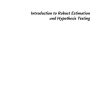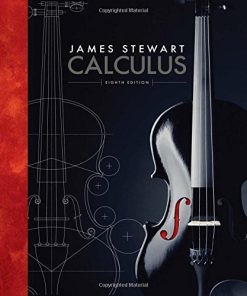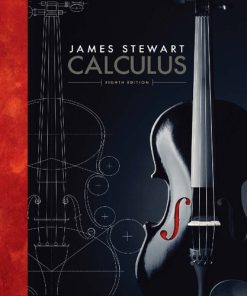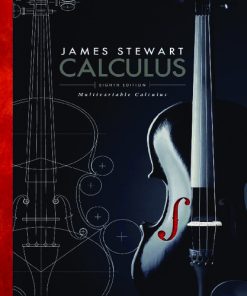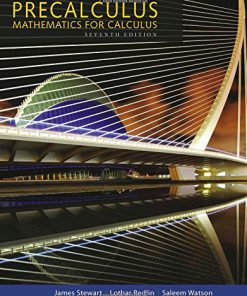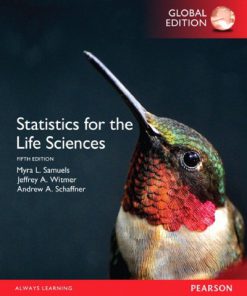Biocalculus Calculus Probability and Statistics for the Life Sciences 1st Edition by James Stewart,Troy Day ISBN 1305114035 978-1305114036
$50.00 Original price was: $50.00.$25.00Current price is: $25.00.
Biocalculus: Calculus, Probability, and Statistics for the Life Sciences 1st Edition by James Stewart, Troy Day – Ebook PDF Instant Download/Delivery: 1305114035, 978-1305114036
Full download Biocalculus: Calculus, Probability, and Statistics for the Life Sciences 1st Edition after payment

Product details:
ISBN 10: 1305114035
ISBN 13: 978-1305114036
Author: James Stewart, Troy Day
BIOCALCULUS: CALCULUS, PROBABILITY, AND STATISTICS FOR THE LIFE SCIENCES shows students how calculus relates to biology, with a style that maintains rigor without being overly formal. The text motivates and illustrates the topics of calculus with examples drawn from many areas of biology, including genetics, biomechanics, medicine, pharmacology, physiology, ecology, epidemiology, and evolution, to name a few. Particular attention has been paid to ensuring that all applications of the mathematics are genuine, and references to the primary biological literature for many of these has been provided so that students and instructors can explore the applications in greater depth. Although the focus is on the interface between mathematics and the life sciences, the logical structure of the book is motivated by the mathematical material. Students will come away with a sound knowledge of mathematics, an understanding of the importance of mathematical arguments, and a clear understanding of how these mathematical concepts and techniques are central in the life sciences.
Table of contents:
Chapter 1: Functions and Sequences
1.1: Four Ways to Represent a Function
1.2: A Catalog of Essential Functions
1.3: New Functions from Old Functions
1.4: Exponential Functions
1.5: Logarithms; Semilog and Log-Log Plots
1.6: Sequences and Difference Equations
1: Review
1: True-False
Chapter 2: Limits
2.1: Limits of Sequences
2.2: Limits of Functions at Infinity
2.3: Limits of Functions at Finite Numbers
2.4: Limits: Algebraic Methods
2.5: Continuity
2: Review
2: True-False
Chapter 3: Derivatives
3.1: Derivatives and Rates of Change
3.2: The Derivative as a Function
3.3: Basic Differentiation Formulas
3.4: The Product and Quotient Rules
3.5: The Chain Rule
3.6: Exponential Growth and Decay
3.7: Derivatives of the Logarithmic and Inverse Tangent Functions
3.8: Linear Approximations and Taylor Polynomials
3: Review
3: True-False
Chapter 4: Applications of Derivatives
4.1: Maximum and Minimum Values
4.2: How Derivatives Affect the Shape of a Graph
4.3: L’Hospital’s Rule: Comparing Rates of Growth
4.4: Optimization Problems
4.5: Recursions: Equilibria and Stability
4.6: Antiderivatives
4: Review
4: True-False
Chapter 5: Integrals
5.1: Areas, Distances, and Pathogenesis
5.2: The Definite Integral
5.3: The Fundamental Theorem of Calculus
5.4: The Substitution Rule
5.5: Integration by Parts
5.6: Partial Fractions
5.7: Integration Using Tables and Computer Algebra Systems
5.8: Improper Integrals
5: Review
5: True-False
Chapter 6: Applications of Integrals
6.1: Areas Between Curves
6.2: Average Values
6.3: Further Applications to Biology
6.4: Volumes
6: Review
6: True-False
Chapter 7: Differential Equations
7.1: Modeling with Differential Equations
7.2: Phase Plots, Equilibria, and Stability
7.3: Direction Fields and Euler’s Method
7.4: Separable Equations
7.5: Systems of Differential Equations
7.6: Phase Plane Analysis
7: Review
7: True-False
Chapter 8: Vectors and Matrix Models
8.1: Coordinate Systems
8.2: Vectors
8.3: The Dot Product
8.4: Matrix Algebra
8.5: Matrices and the Dynamics of Vectors
8.6: The Inverse and Determinant of a Matrix
8.7: Eigenvectors and Eigenvalues
8.8: Iterated Linear Transformations
8: Review
8: True-False
Chapter 9: Multivariable Calculus
9.1: Functions of Several Variables
9.2: Partial Derivatives
9.3: Tangent Planes and Linear Approximations
9.4: The Chain Rule
9.5: Directional Derivatives and the Gradient Vector
9.6: Maximum and Minimum Values
9: Review
9: True-False
Chapter 10: Systems of Linear Differential Equations
10.1: Qualitative Analysis of Linear Systems
10.2: Solving Systems of Linear Differential Equations
10.3: Applications
10.4: Systems of Nonlinear Differential Equations
10: Review
10: True-False
Chapter 11: Descriptive Statistics
11.1: Numerical Descriptions of Data
11.2: Graphical Descriptions of Data
11.3: Relationships between Variables
11.4: Populations, Samples, and Inference
11: Review
11: True-False
Chapter 12: Probability
12.1: Principles of Counting
12.2: What Is Probability?
12.3: Conditional Probability
12.4: Discrete Random Variables
12.5: Continuous Random Variables
12: Review
12: True-False
Chapter 13: Inferential Statistics
13.1: The Sampling Distribution
13.2: Confidence Intervals
13.3: Hypothesis Testing
13.4: Contingency Table Analysis
13: Review
13: True-False
Chapter A: Appendixes
A.A: Intervals, Inequalities, and Absolute Values
A.B: Coordinate Geometry
A.C: Trigonometry
A.D: Precise Definition of Limits
A.E: A Few Proofs
A.F: Sigma Notation
A.G: Complex Numbers
A.H: Statistical Tables
A.I: Glossary of Biological Terms
A.J: Answers to Odd-Numbered Exercises
Chapter DT: Diagnostic Tests
DT.1: Basic Algebra
DT.2: Analytic Geometry
DT.3: Functions
DT.4: Trigonometry
Chapter QP: Quick Prep Topics
QP.1: Definition and Representations of Functions
QP.2: Working with Representations of Functions
QP.3: Function Notation
QP.4: Domain and Range of a Function
QP.5: Solving Linear Equations
QP.6: Linear Functions
QP.7: Parabolas
QP.8: Factoring Quadratic Equations and Finding x-intercepts of a Quadratic Function
QP.9: Polynomials
QP.10: More about Factoring Polynomials
QP.11: Finding Roots
QP.12: Dividing Polynomials
QP.13: Rational Functions
QP.14: Root Functions
QP.15: Rationalizing the Numerator or Denominator
QP.16: Exponential Functions
QP.17: Logarithmic Functions
QP.18: Trigonometric Functions and the Unit Circle
QP.19: Graphs of Trigonometric Functions
QP.20: Trigonometric Identities
QP.21: Special Functions
QP.22: Algebraic Combinations of Functions
QP.23: Composition of Functions
QP.24: Transformations of Functions
QP.25: Inverse Functions
People also search for:
calculus probability
is probability part of calculus
is probability in calculus
do you need calculus for probability
do you need calculus for probability and statistics
Tags: James Stewart, Troy Day, Biocalculus Calculus, Probability and Statistics, for the Life Sciences
You may also like…
Mathematics
Mathematics - Mathematical Statistics
Mathematics
Mathematics


